She was certainly one of the most anticipated boats of this year´s Boot Duesseldorf. Now that most of this usual „first-day craziness“ about the boat has flattened out, I´m ready to publish my article. Sadly, it is often the same with all the hustle and big buzz: People tend to overstate, exaggerate and distort things being caught in the situation. So, sometimes it is better to wait, to calm down and think it over. Now, here we go, I´m ready. Although I admit, in this case, most of the buzz and hustle turned out to be true. But let´s start at the beginning …
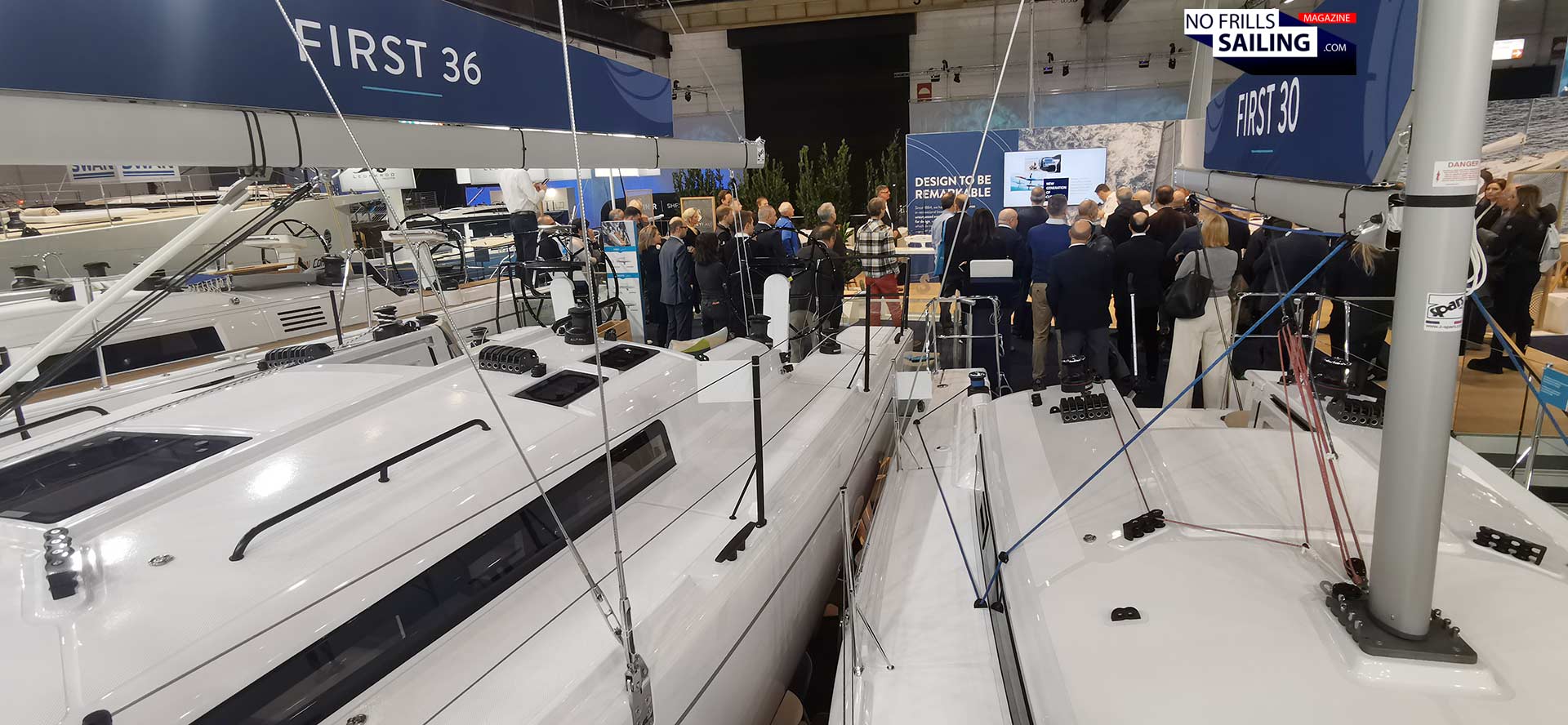
When I arrived at the Beneteau stand one day before the public opening of the boat show, the whole area was crowded: Shipyard representatives, guys from the press, the dealers and other officials had gathered around Andraz Mihelin and the Seascape-crew for a welcome drink. Let´s call it an unofficial unveiling of the new First 30. Well, that´s understandable: The First 30 is a benchmark-boat for Beneteau, something like maybe the 911 is for Porsche or the 737 for Boeing. The First 30 was the first ever leisure GRP-boat built by the French …
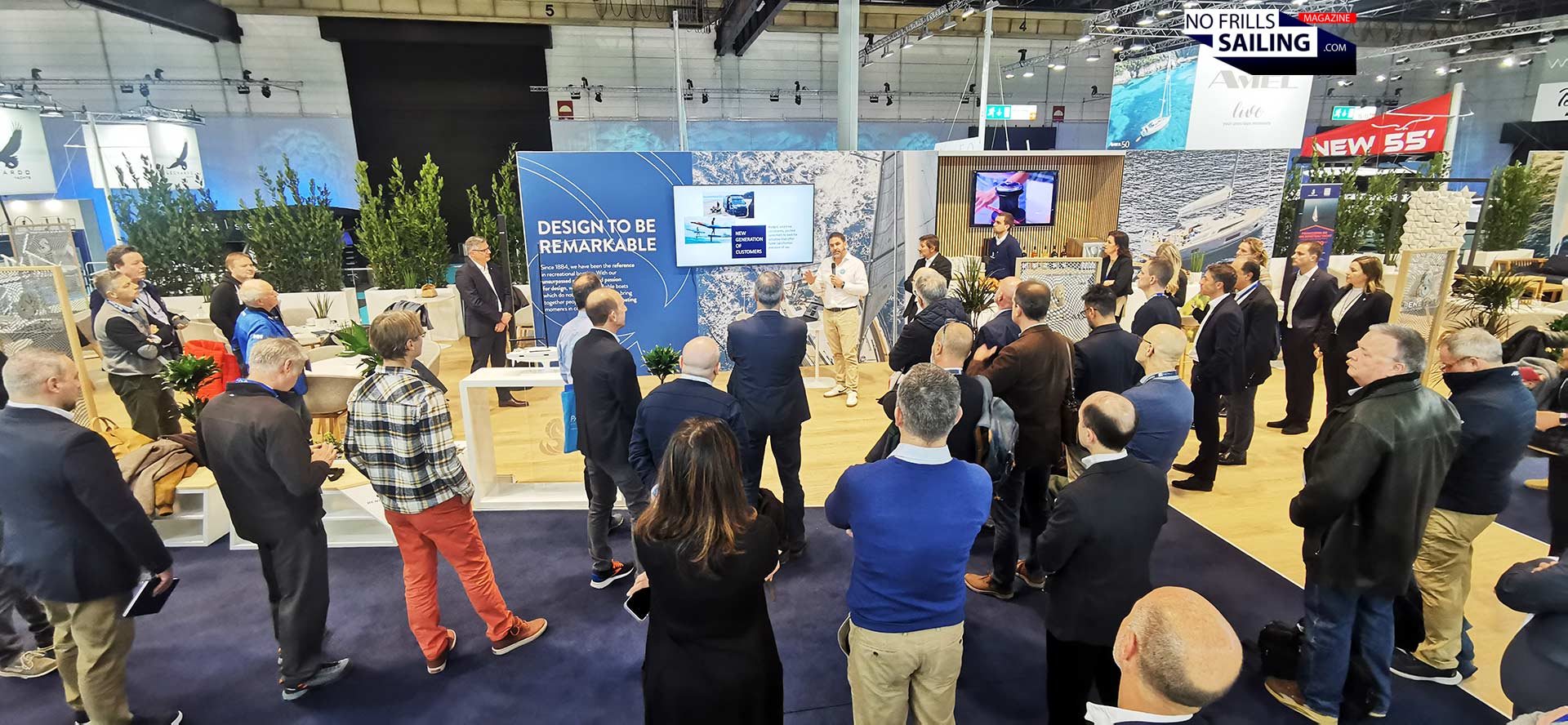
In this, you can imagine how important this new entry is for the company. Even more in a market in crisis and – let´s only mention it briefly – after the rather disappointing performance of the last First 30, the Juan K-designed version. Pressure was on and the fact that the French trusted their iconic baby to be made by their Slovenian partners from Seascape shows even more how times have changed. The success of reviving the smaller sized boat-range by the partnership with Seascape created the fruitful soil on which the new seeds for the boat could be planted and grow. And it did so because the gardeners, if we want to remain in this picture, are among the best of their guild.
The Gordian knot of sailing: Fast and cozy
„First“ for Beneteau, this always meant exceptional sailing performance with an emphasis on cruising in style. Even before the Oceanis-range had been invented (which in itself is also a very interesting story, almost historical – maybe I tell it later in a dedicated article) the Beneteau First was always well-known for her speed, comforts and – being a series production boatbuilder – her reasonable price. So, how can you translate this into a boat of the 21st Century? As Andraz Mihelin once puts it in an interview of the then-new First 36: „We summoned the Avengers of Sailing“.
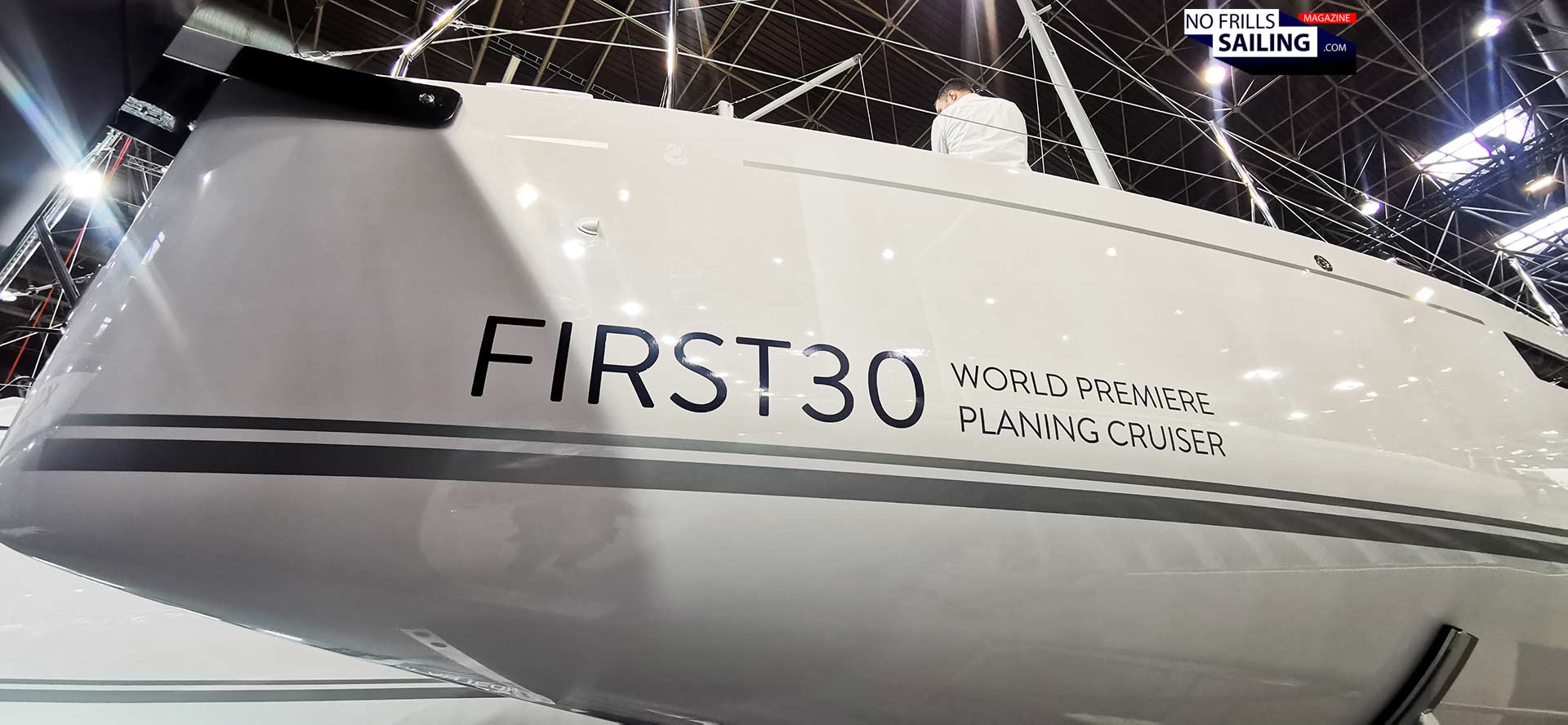
Having said that, when participating in the above mentioned „unveiling“ of the First 30 that day, I found myself standing right next to Wunderkind Sam Manuard (who designed the hull of the First 30) and Champion Lorenzo Argento, who again was responsible for the „above waterline“-design of the boat. Many more had been involved in the making, like Pure Design for structural engineering and Sito for the interiors. Truly impressive. In this, the aspirations of the new boat are clearly formulated in the claim which is to be used in all communications about her: „The effortless joy of planing“. First 30 is nothing more or less than a new breed, a new class of sailboats, as Beneteau puts it: The Planing Cruiser.
Completing the range
Before I dive deeper into the planing aspects of the First 30, it is essential to acknowledge that the new boat at last stuffed a gaping hole, a „wound“ as one salesman described it, in their product range. Up until now, the First-boats (meaning the Seascapes) had been available from 14, 18, 24 up to 27 feet with leaving a gap around 10 meters, only to have a new 36-footer, the 44 and the flagship, the First 53. The new First 30 closes that gap.
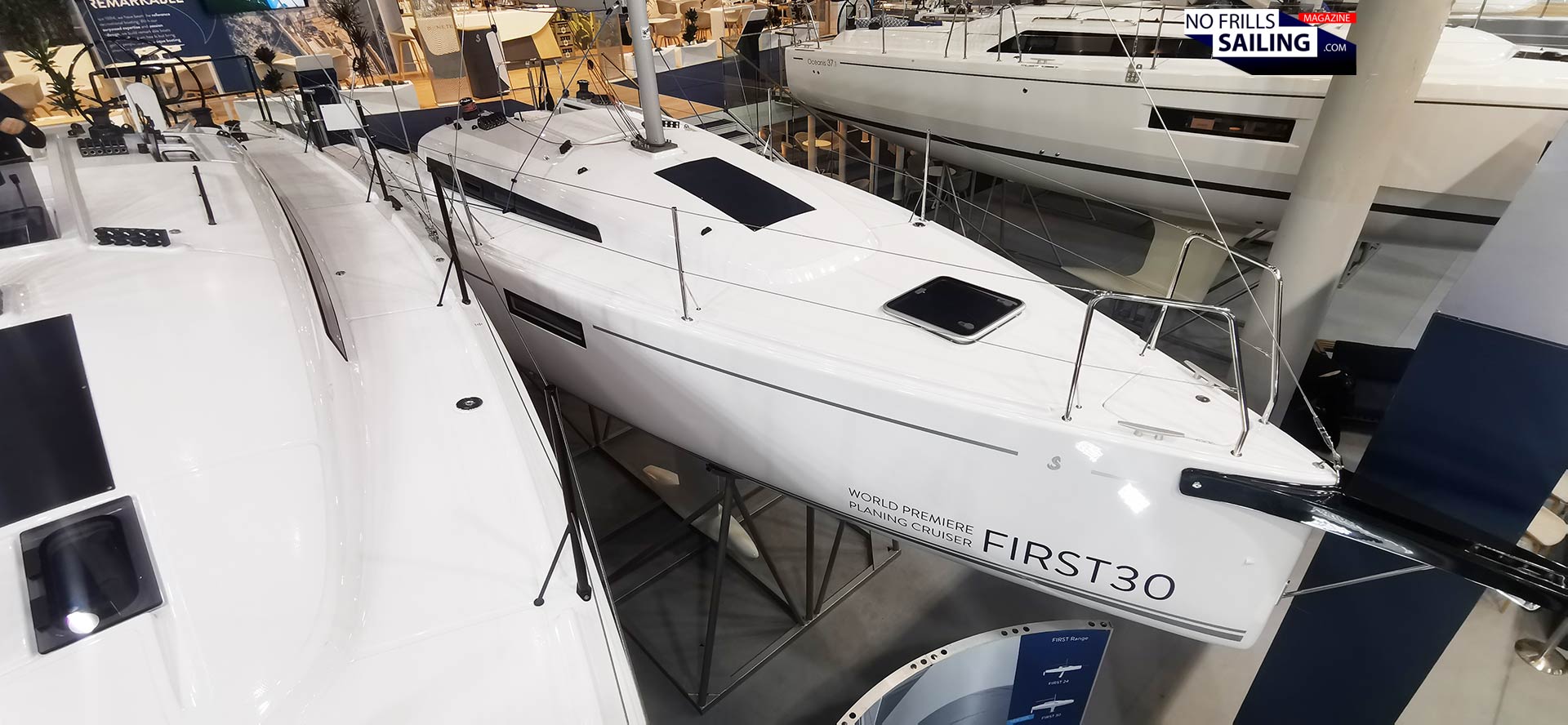
That´s important because 10 meters is something of a „goldilock zone“ of performance boating. With the huge, huge boom of single- and doublehanded amateur racing and a common trend towards smaller, but more versatile, more „fun“ boats, not having an offer for the 30 feet-clients did cost Beneteau a lot. I am not selling actively anymore, but I could pick 15, maye 20 prospect buyers for the First 30 out of my phone at an instant. There is so much potential here!
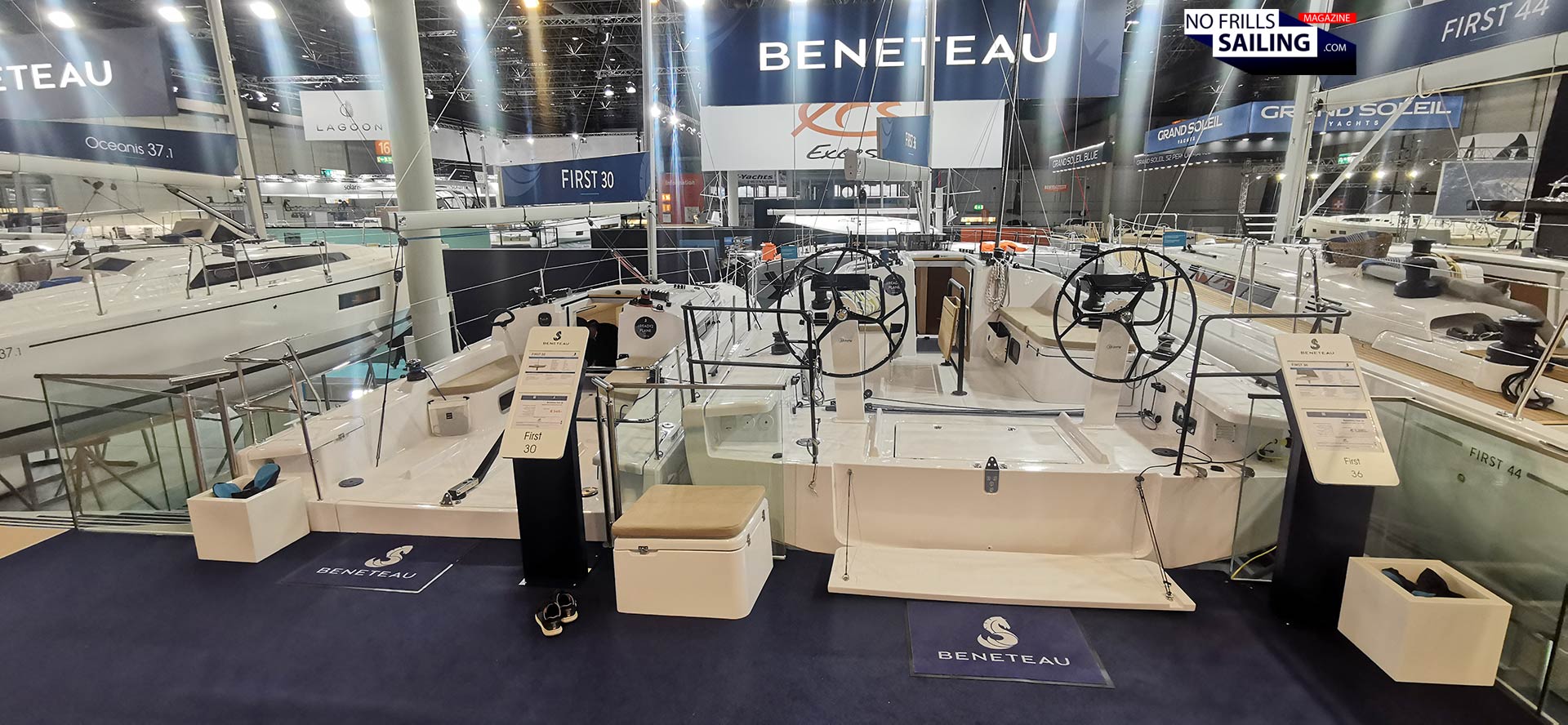
Much more when you look at the price of the new First 30. I don´t often speak specifically about boat prices and budgets on NO FRILLS SAILING. For a reason. But this time it is different. The current starting price for the First 30 is 100.000 Euros exVAT, so the finished boat with sails, transport and commissioning will end up around 150.000 to 170.000 Euros all in. That´s a great price! Especially as we´ve seen a surge in boat budgets (along with the general inflation of literally all prices, be it butter or housing) and that´s of course a big problem: For many boat builders the once safely performing bread-and-butter-market of boats from 35 to 45 feet has, well, kind of flatlined in the past two years. A large part of those clients downgraded in terms of boat size to smaller boats (which is a good thing) – so, having a proposal here is exactly what a shipyard should be doing right now.
When singlehanded sailing meets family cruising
Current situation in 30 feet boats with a similar setup is also promising. Meaning, there aren´t many: Pogo just splashed their latest 30 footer, the Pogo RC, which is an all-out racer. Dehler´s 30 OD isn´t even on the official website of Hanse/Dehler anymore and it has been „a bit calm“ recently regarding Jeanneau´s two years old SunFast 30 OD. On the other hand, the Oceanis 30.1 is still performing very well in terms of sales figures – and I personally love this small 10-meter-boat so much! Now, with the First 30 you get a similarly sized boat. But with much, much more sailing fun!
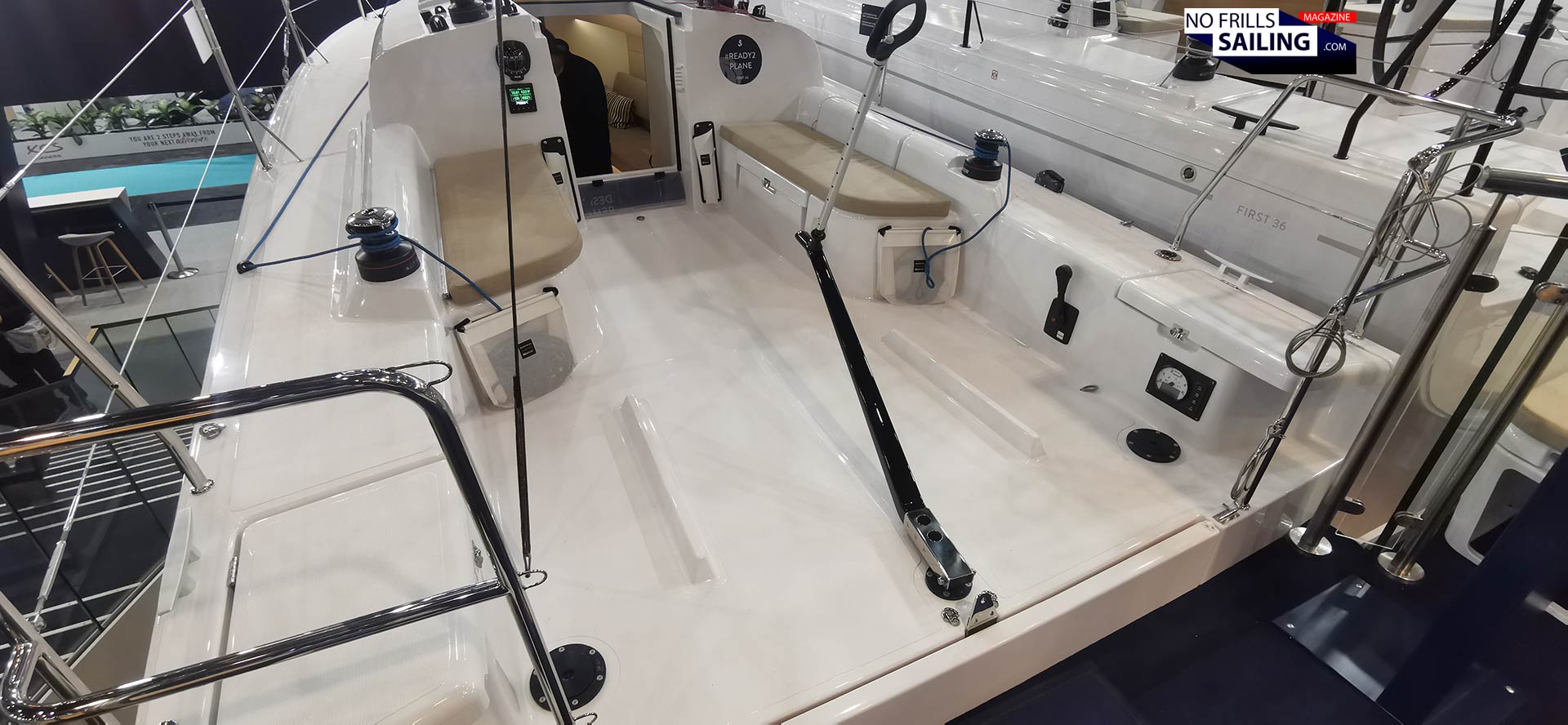
The First 30 has a large cockpit that is nicely proportioned to function for both racing and cruising. A single tiller on two rudder blades, working and Genoa winches well at hand with a nice seating bench in between. The coamings are wide enough for comfortably sitting at the rear for helming the yacht. Also, equipped with cushions, the benches are very nice for cruising. This was, if you remember my old postings about my sailing adventures with the First 27 SE GEKKO, always a problem when I was sailing with my kids or partners: They had to uncomfortably spend the time on the rough, hard cockpit bottom. No fun when sailing 80 miles-legs …
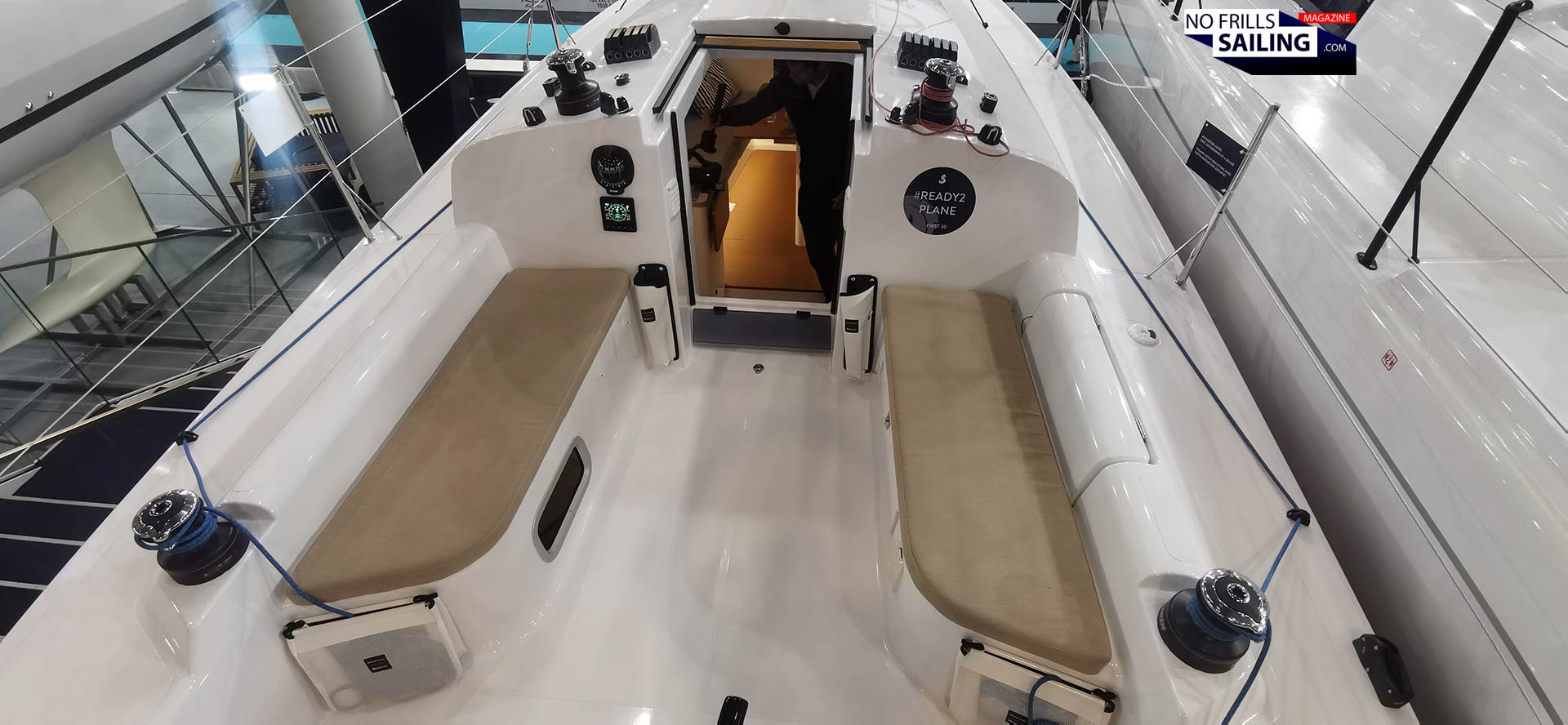
That means that people don´t have to be down on the bare deck anymore on the First 30 though! That´s a good thing. Having the benches also means that there is volume created below them. On starboard side you´ll find a nice big and deep aft locker, similar to the one on the Oceanis 30.1. Here all your fenders and surplus stuff can be stowed away dry and safely. To port side, underneath that bench is the aft cabin about which we´ll talk later. Of course, the „racing“-pack of the First 30 options-list includes a mainsheet traveler which I guess we all agree upon must be opted for when buying that boat.
Only the good stuff
As I said, a First isn´t a First when she´s not sailing in a sportive way. This of course applies to this boat as well. You now it, I am passionate for Seascape-made boats myself and one thing I liked especially was the choice of parts and fittings. Winches, jammers, cleats, ropes and such: Never the lowest shelf, never under-sized, never the cheap stuff to hold a nice low price. The new First 30 is equipped with onboard electronics by Garmin, a decision which I also fancy.
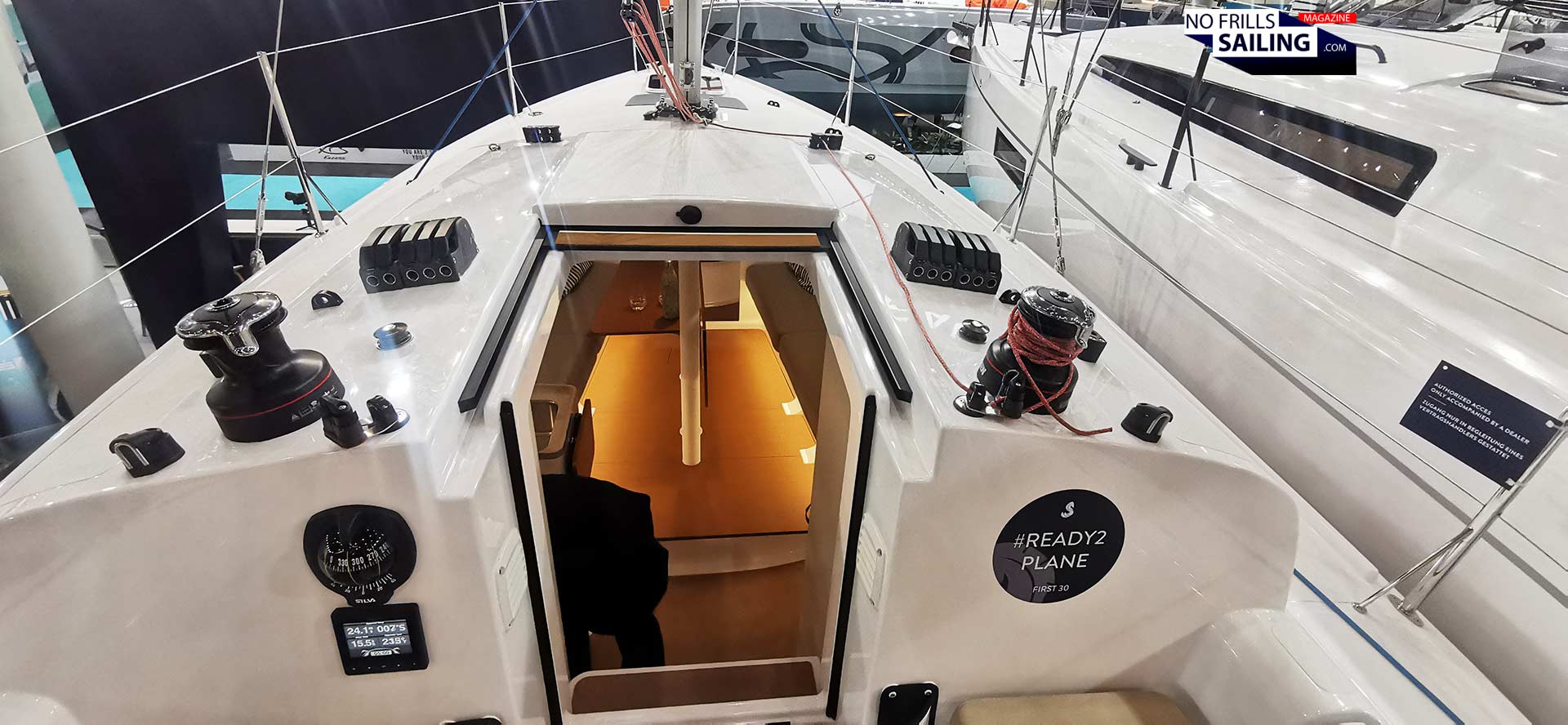
Judging by the exhibited boat, there´s not much to say really as she was presented a bit „naked“. The guys told me that they had worked their asses off to being able to show the boat in January: Having started the building process in past October really, that´s a pretty short time to make a complete boat! More so if you consider the fact that the one on display was literally hull number one. „She dried on the truck on her way here …“, as Tit Plevnik jokingly said. So I will have to publish another in-depth article hopefully soon about her full running rigging and also her sailing properties.
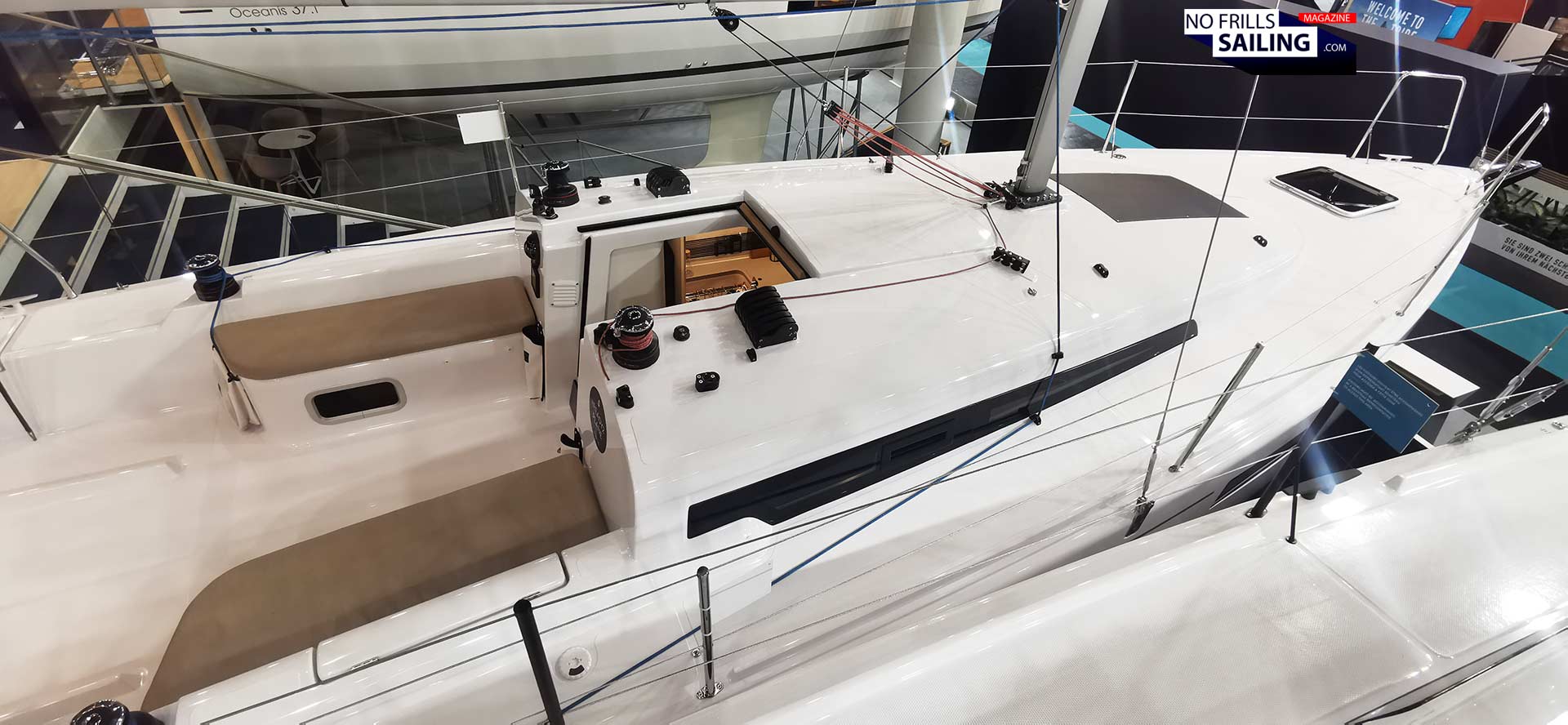
The boat in Duesseldorf lacked, as I already said, a proper mainsheet traveler. Instead a rather awkward German-style mainsheet puzzled many visitors. Anyway, as the first boat is in the water by now (it´s mid February when this article is published) we will surely soon see more of this type with proper and complete rigging. For what I´ve seen triming instruments (3D Jib finetuning), winch-sizes and quality of fittings is – as expected – quite high. I know, I should put more emphasis on sailing and – as promised in their claim – on planing, but that´s for later. The true Wow!-effect unfolded for many visitors when the went down below.
Cover model: Inside the First 30
And what an entry this is! Truly and honestly, hats off to the designers! The First 30 welcomes you with a very, very light, friendly, warm and cozy feel – albeit she is virtually „empty“ for the sake of weightsaving. What the connoisseur will notice right away is the effort that went into crafting a very smooth and nice B-side of the deck´s underside. In this, the boat doesn´t really need any roofing panels or covers. Of course there´s a small one in the central saloon to house the cables coming down from the mast and the indirect lights.
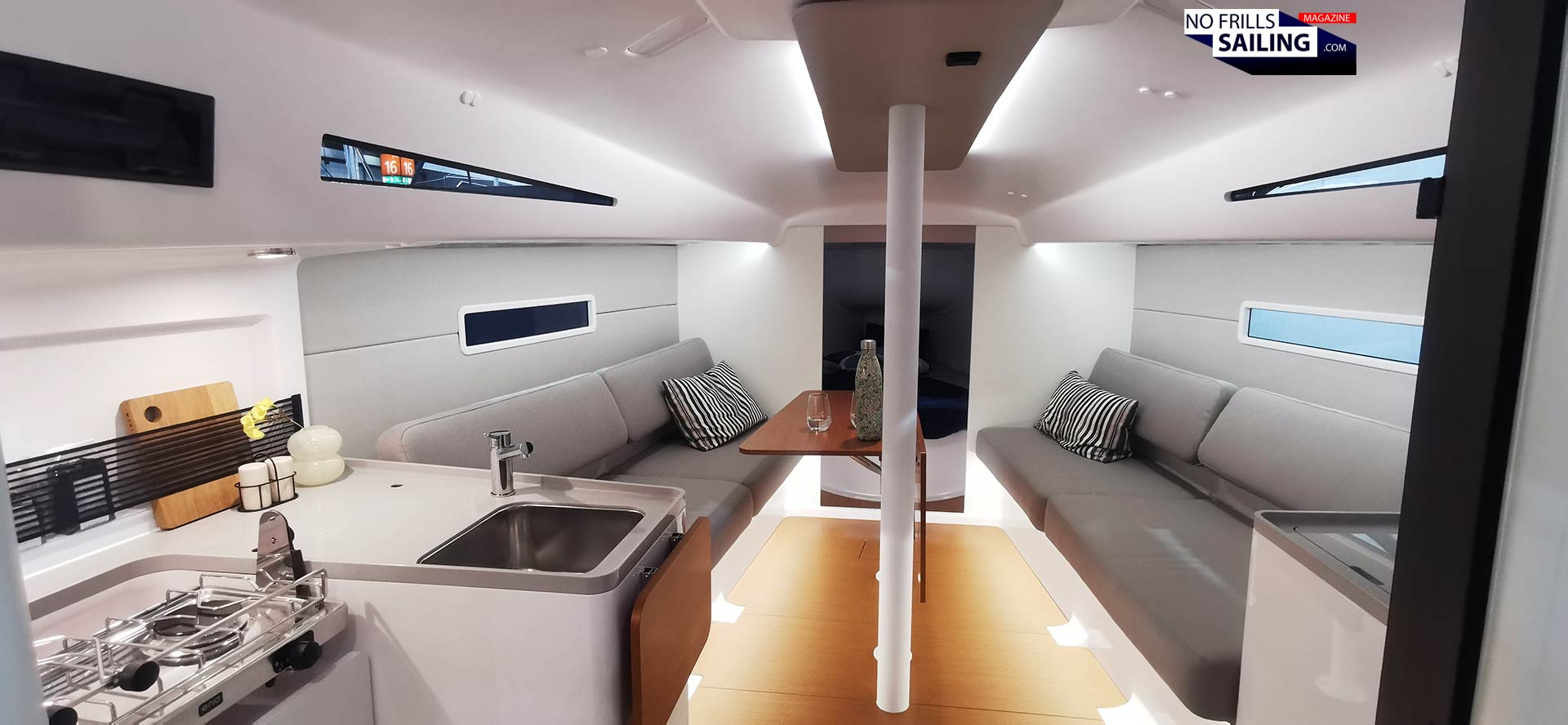
The light concept is worth a mentioning: The First 30 does not have any classic lights but is completely equipped with indirect LED-strips. This decision saves electric current consumption on the one hand but is also responsible for much of the nice, rich feeling that is created in her saloon. There is plenty of volume inside. Especially the width of 2.99 metres creates a certain feel of size. Although real standing height is only given in the entrance area and galley, as you are mostly sitting down or even laying down in the saloon, that´s more than okay for me.
XXXXXBILD 11
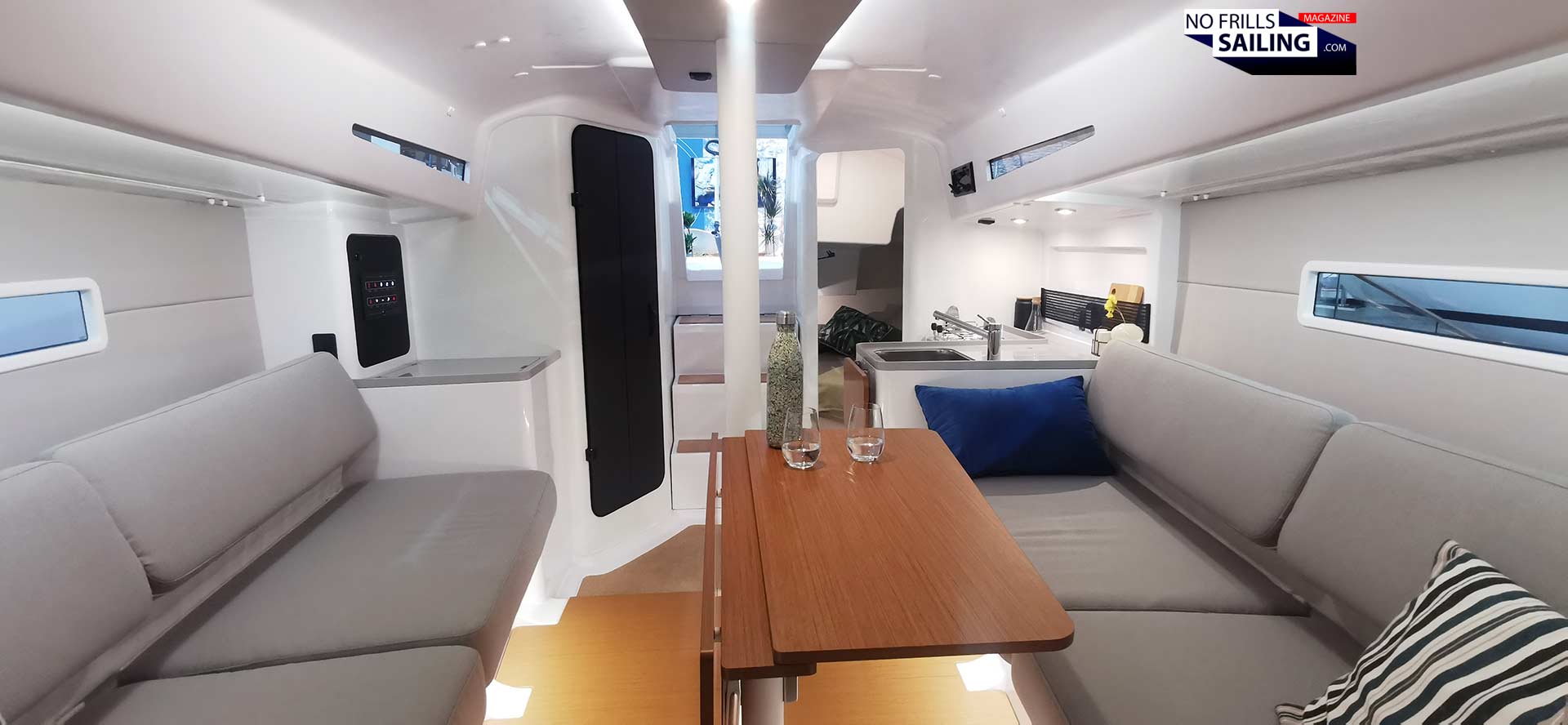
The layout is classy: A galley to port side with the bathroom vis-a-vis. Two more than 2 metres long saloon benches to either side of the saloon with a nicely sized hull window for each. As there is no skylight or opening deck-hatch for the saloon and the windows in the coachroof are relatively thin, those hull windows are needed to have at least a bit of natural side inside the cabin. You remember my comparison article between First 27 SE and First 27? For these two boats it was pretty apparent how big of a thing is changed even with the addition of small windows. I´m happy that the designers made the hull windows that big, it will be an awesome sight when the boat is sailing, I´m sure!
A true cruising boat
This boat is solely available in a 2-cabin layout with one bathroom. I will show the cabins later. As for the saloon, there is an interesting detail to explain (but I didn´t picture it, I´m sorry). You can see the backrests of the saloon benches in the picture above? Those can be flipped over with a simple movement of the hand. They will „diappear“ in the area between backrest and hull (which is also to be used for stowing away some stuff). In this the saloon sofas are turned into sleeping benches – and no running around with loose cushions anymore. I like these simple yet effective ideas of Seascape!
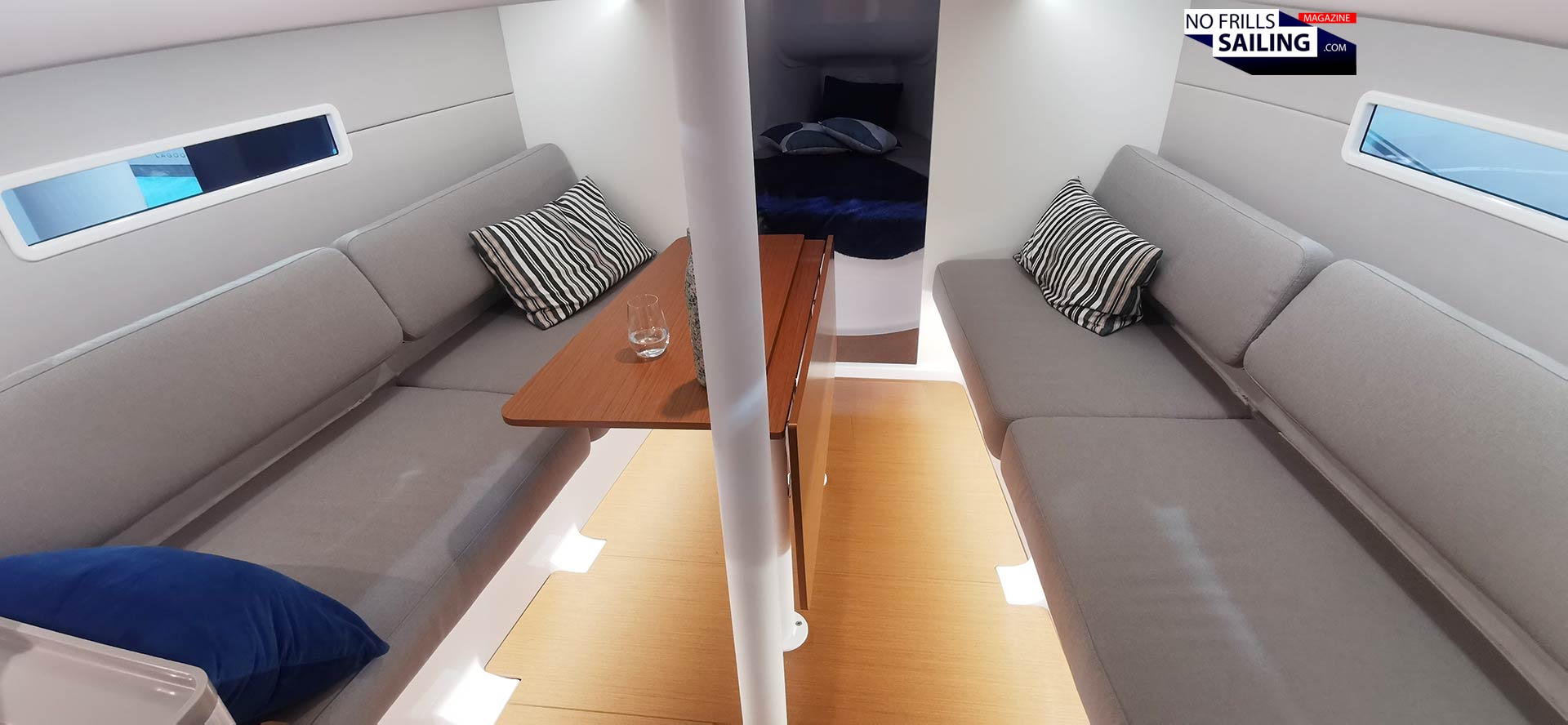
Another nice idea can be seen in the next picture: To starboard side, just adjacent to the bathroom cabin bulkhead, the shipyard has fitted the main switchboard and a small „chart table“. This is, frankly, a chart table that can only be used whilst standing – a concept I also have built into my own new boat, the Omega 42. This is very clever: No „waste“ of space and volume for the much controversial chart table (as many like it, many hate it) but also giving it a second function, is, frankly, ingenious.
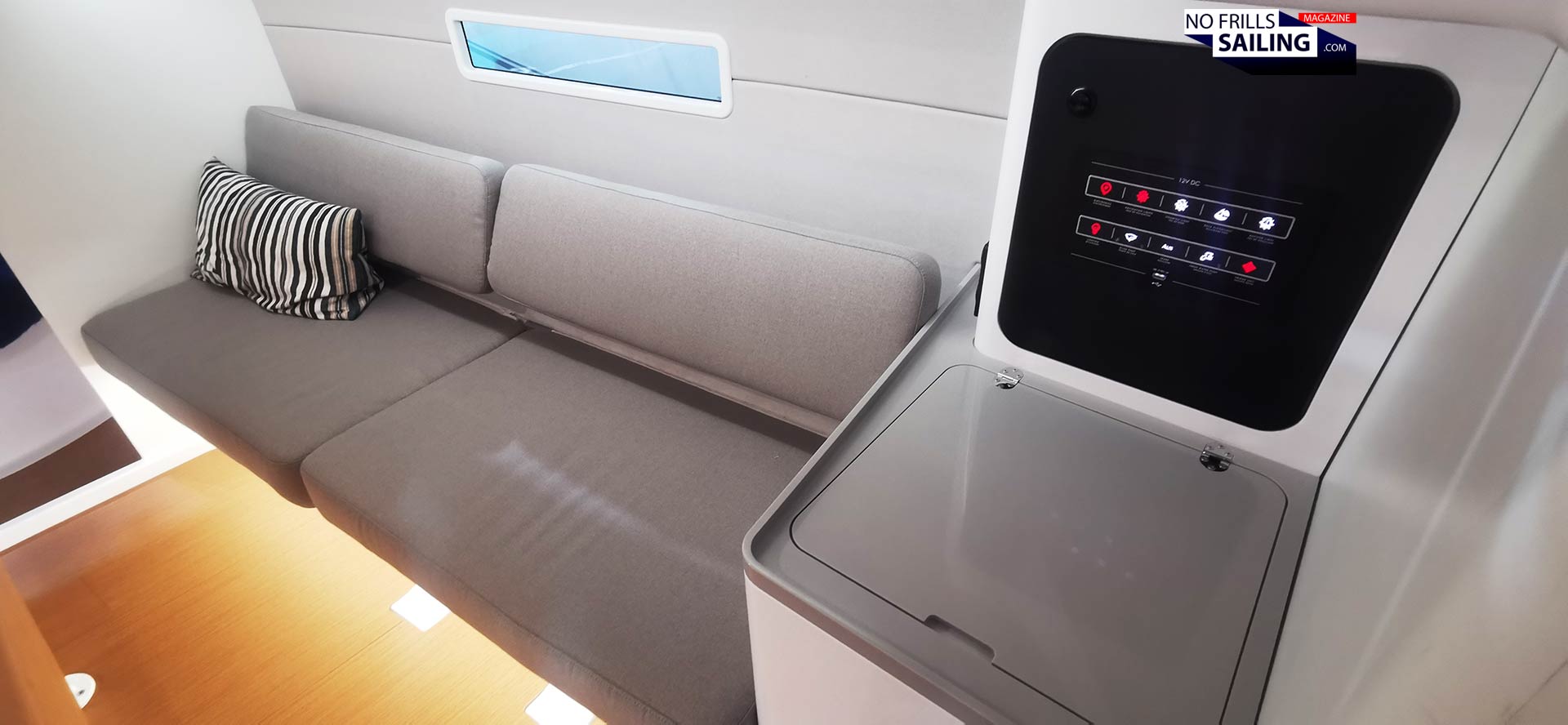
Because this „chart table“ can be opened – and is your boat´s top loading fridge! How cool is that?! As the width of the First 30 is not enough to fit the iconic central fridge column as they have done in the First 36, this is a cool solution. It saves space for more stowage in the galley, makes use of the volume available to starbord and they can at least fit a „stand in front“-chart table. These are those little details which make me smile.
Proper galley for the ship´s cook
As for the cruising amenities, eating and personal hygiene are two of the most important aspects of a boat that is to be used for vacational sailing. In this, the First 30 offers both of them – and both in decently sized volumes! I personally love being the ship´s cook when underway. But more than that, I love having a hot drink during a long dark night´s watch. Many sailing families I know fancy having self-cooked meals so this is a very important place.
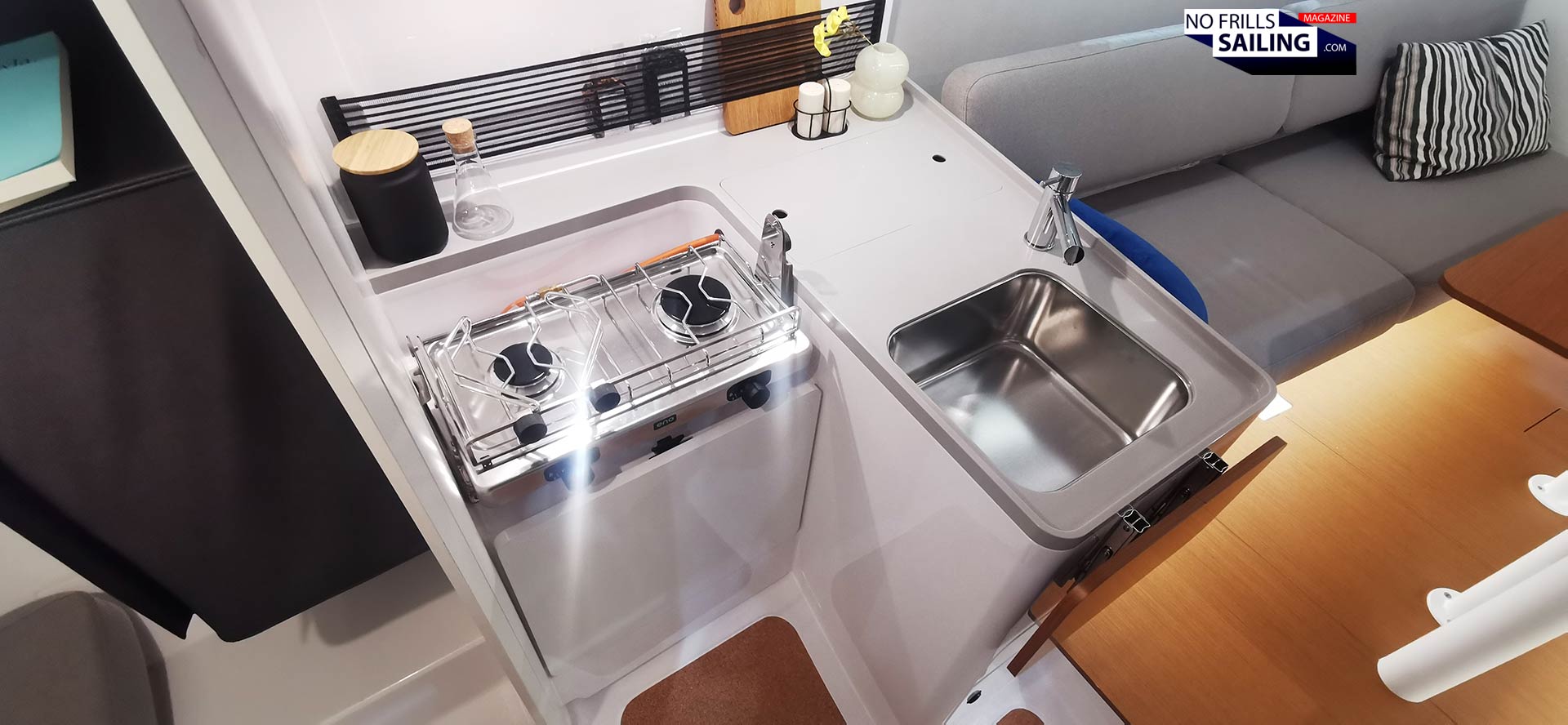
Now look at this galley: Simple, neat and clever. I´ve already shown you the fridge, so that´s volume already saved for more stowage here. The First 30 only comes with a standard two-flame cooktop. No oven. Again, that´s a trend I see in many boats recently, especially the more performance-oriented yachts like XR-41 or ClubSwan 43. In my Omega 42 there won´t be an oven either: I simply don´t need to bake when sailing! So, just a two-flame cooker. Plenty of stowage here, and I would say it´s more than that of the Oceanis 30.1 …
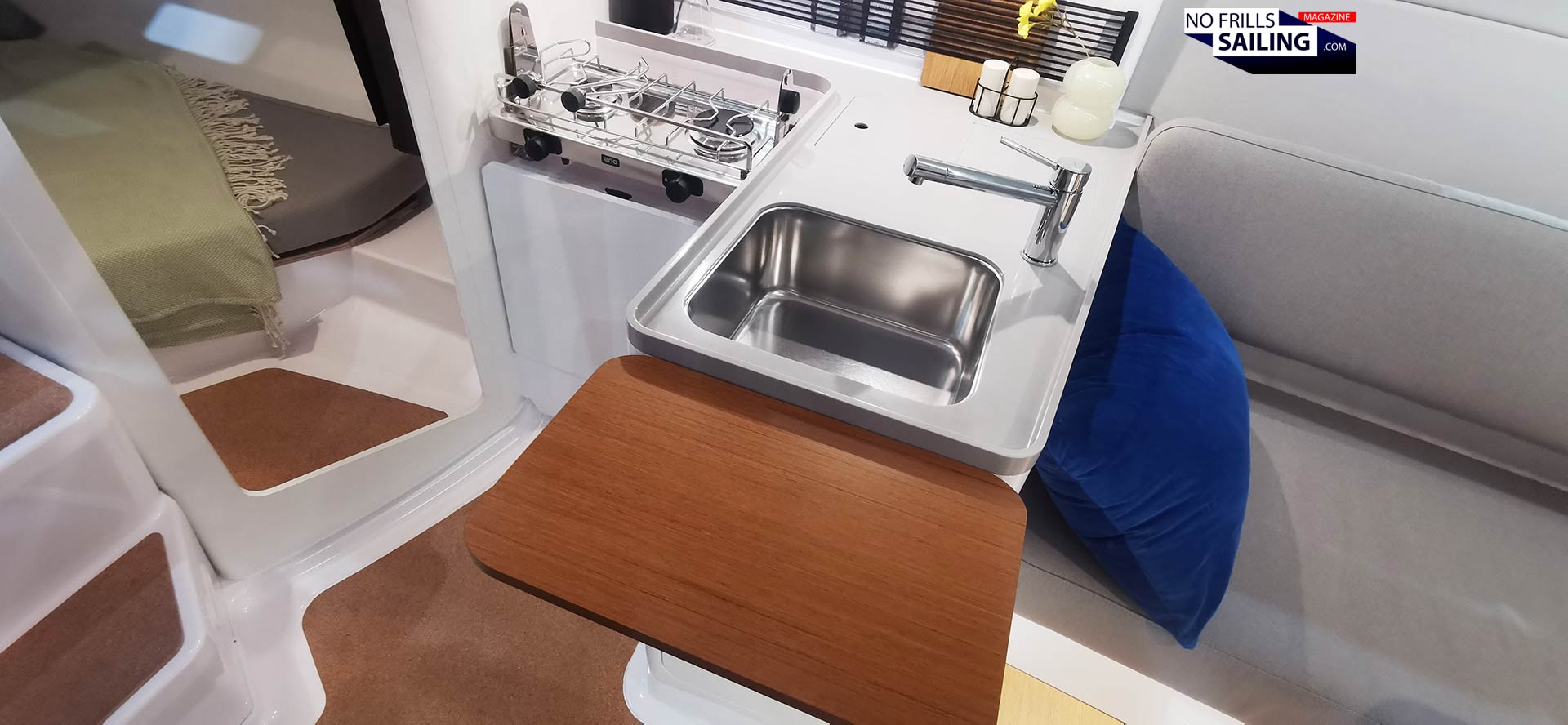
To enhance the cooking- or work-area, there is a simple chopping board to the galley´s side. You just fold it up (like the table-tops in the saloon) and use it, fold it down after cooking is done. Again, a simple, effective solution. I´ve written an article one or two years ago about the then-new First 27, stating, that if this version would have been available back then when I had bought the First 27 SE, I´d rather not having sold it. With this in mind I am perfectly sure that if I had have the opportunity to buy the First 30 back then, I certainly would have kept it! Meaning: My partner would have had her porper galley and – more important – a real bathroom.
Biggest bathroom of her class?
And indeed, she approved the First 30 when I showed it to her during the boat show. Reciting her: „That would have been the perfect GEKKO!“ Well, of course, I would never miss my current project, the building of the Omega 42, but it is really worth a thought. The First 30 has everything I ask for in a sailboat: Performance, decent size, comfort, galley and – finally – the bathroom.
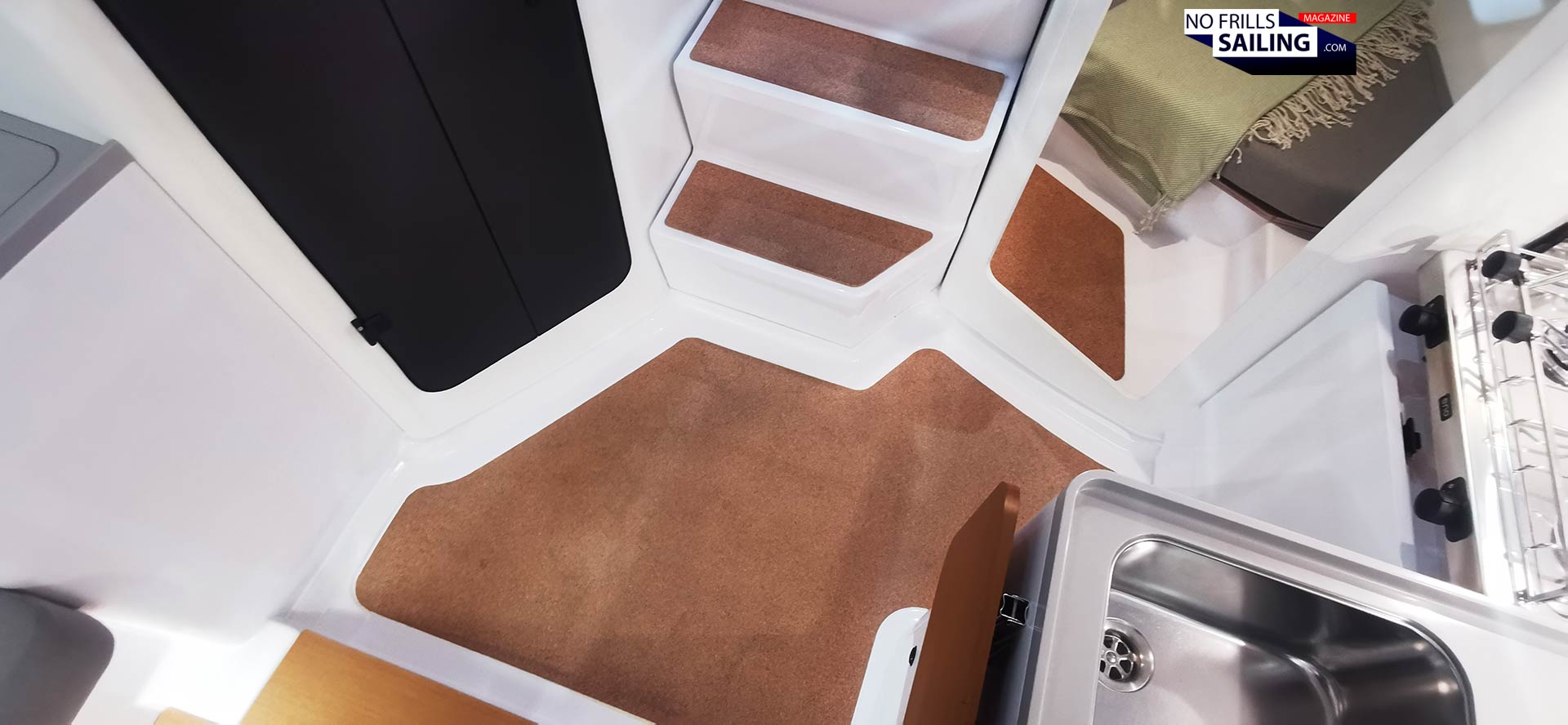
How important it is to being able to take a dump in comfort and privacy I have already written in an article aboard GEKKO. This is, by the way, one reason I disliked the interiors of the Dehler 30 OD: The inability to really close off the bathroom in that boat made it a dealbreaker, at least for me personally. Now, back to the First 30. Her bathroom is situated vis-a-vis the galley. You may enter it by opening the folding magnetic door. Seascape uses these in the First 27 as well and they work absolutely fine. Again: Lightweight, easy, simple.
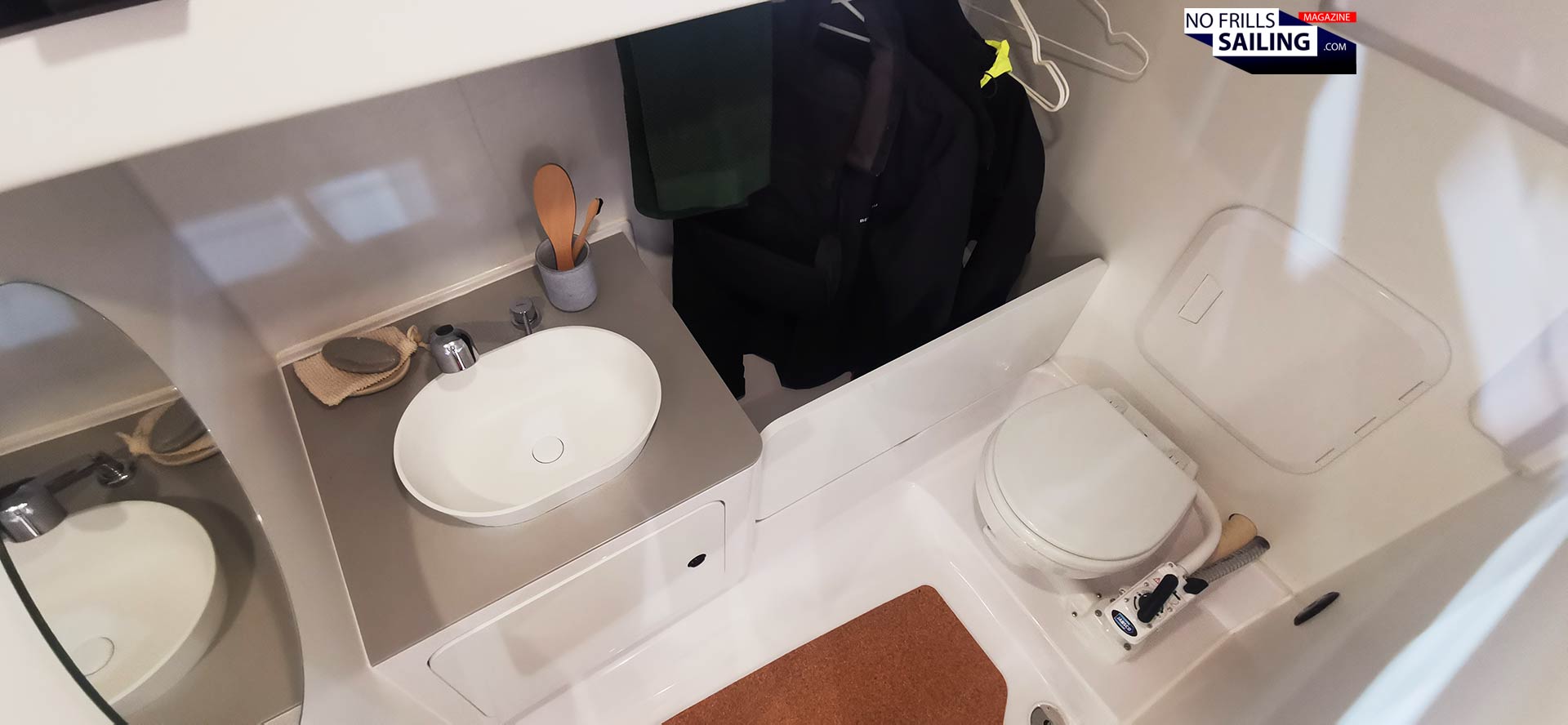
Inside the bathroom you will find surprisingly much volume. The pumping-WC is situated at the rear bulkhead where there´s also a closing hatch into the big aft locker. Beind that hatch the valves for the bathroom are located for easy reach. A small sink, some stowage for hygiene stuff and a nicely round mirror complete the bathroom. To the hulls´s side a large wet hanging locker has been fitted by the shipyard. A solution that will be much appreciated by racing crews because now you have a location to put your soaken sailing gear instead of having it wetting the living area.
Two cabins – no doors
Ten metres, that´s not a big boat. In this, two cabins are more than enough. This configuration will make for good room for the cabin´s occupants when used in single-mode while at the same time ensure a reasonable space for four people onboard. Let´s start with the aft cabin. It is made to snug around the engine hoising, like it is the case with so many cabins.
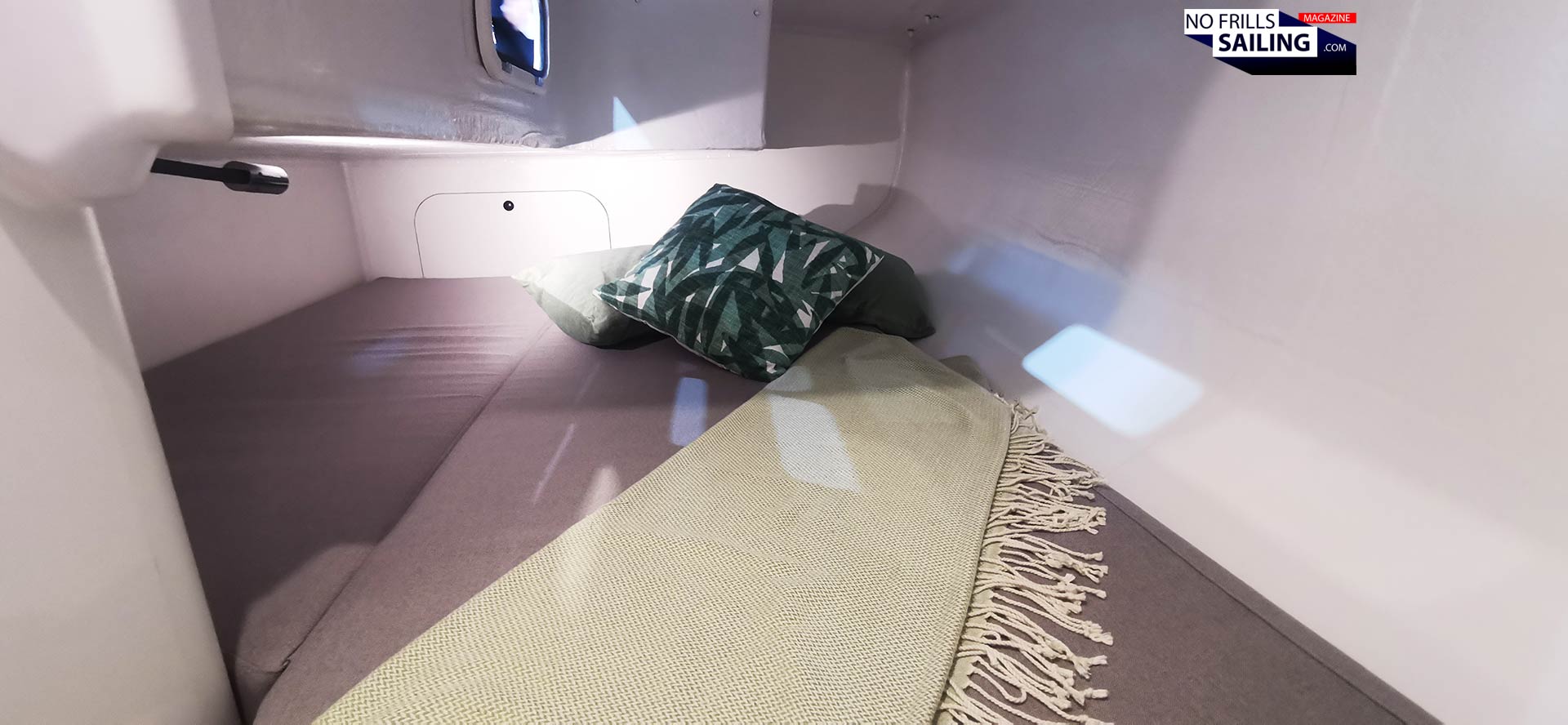
Shorter people might not use the inner bed or, if used by a couple, some cuddling is to be applied. Or your beloved diagonal sleeping position. I personally found the size of the bed absolutely fine (I am 1.86 metres tall). As usually, when sailing, you more want to have a rather narrow bed that prevents you from rolling around as the boat goes through the waves. The front cabin is similar:
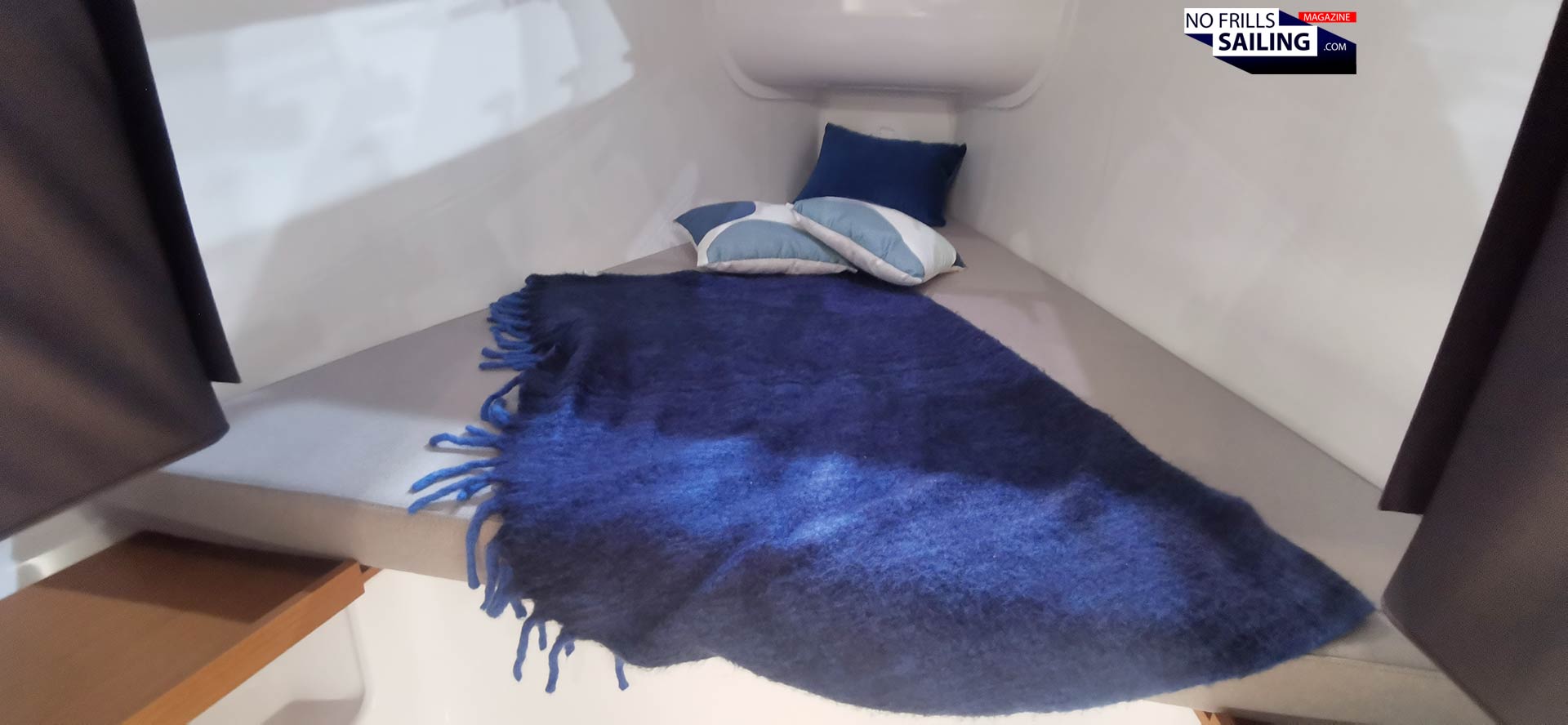
A simple V-shaped berth that will easily house two people. I´ve slept with my partner and my kids (two of them!) in the same – but much smaller sized – forepeak aboard the First 27 SE and I can assure you that this is more than enough to find a good night´s sleep. What I found interesting aboard the First 30 is that there are no doors whatsoever but also no curtains or similar mechanisms to close off the cabins (at least visually) for more darkness and privacy. If they don´t add these to the options list, it will be easy to come up with a DIY-solution here.
Things I like, and things I don´t like about the new First 30
For the most part I have only but praise for this boat. I haven´t seen major flaws or shortcomings but rather simplistic, easy and effective solutions for problems. Creativity and the fun of coming up with those little cool things is a trademark of the Slovenians. A treat in a business that all-too often is just your ordinary, disappointing infusion of the same old things. But of course, not everything is perfect – even for the market leader Beneteau and their unbeatable team of the „Avengers of Sailing“.
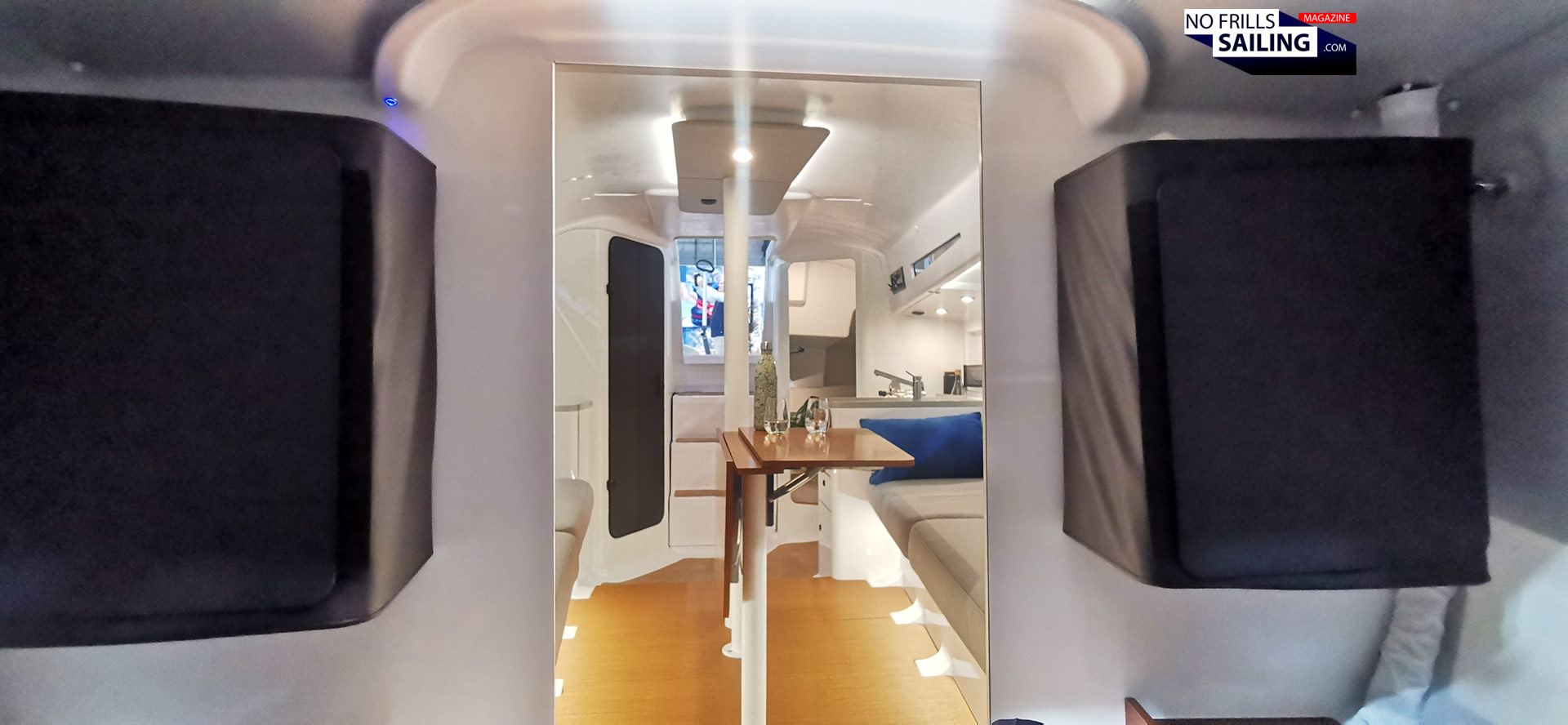
For example, I liked their textile hanging lockers. If you have already read my article on the ClubSwan 43 you may have noticed those in this yacht. Nautor has a similar approach here to offering lightweight, easy to use yet removable cabinets for their cabins. Same in the First 30. But unlike Nautor, their garment-cabinets are not as beautiful and sexy by design. There´s much to improve here, though I absolutely love the concept.
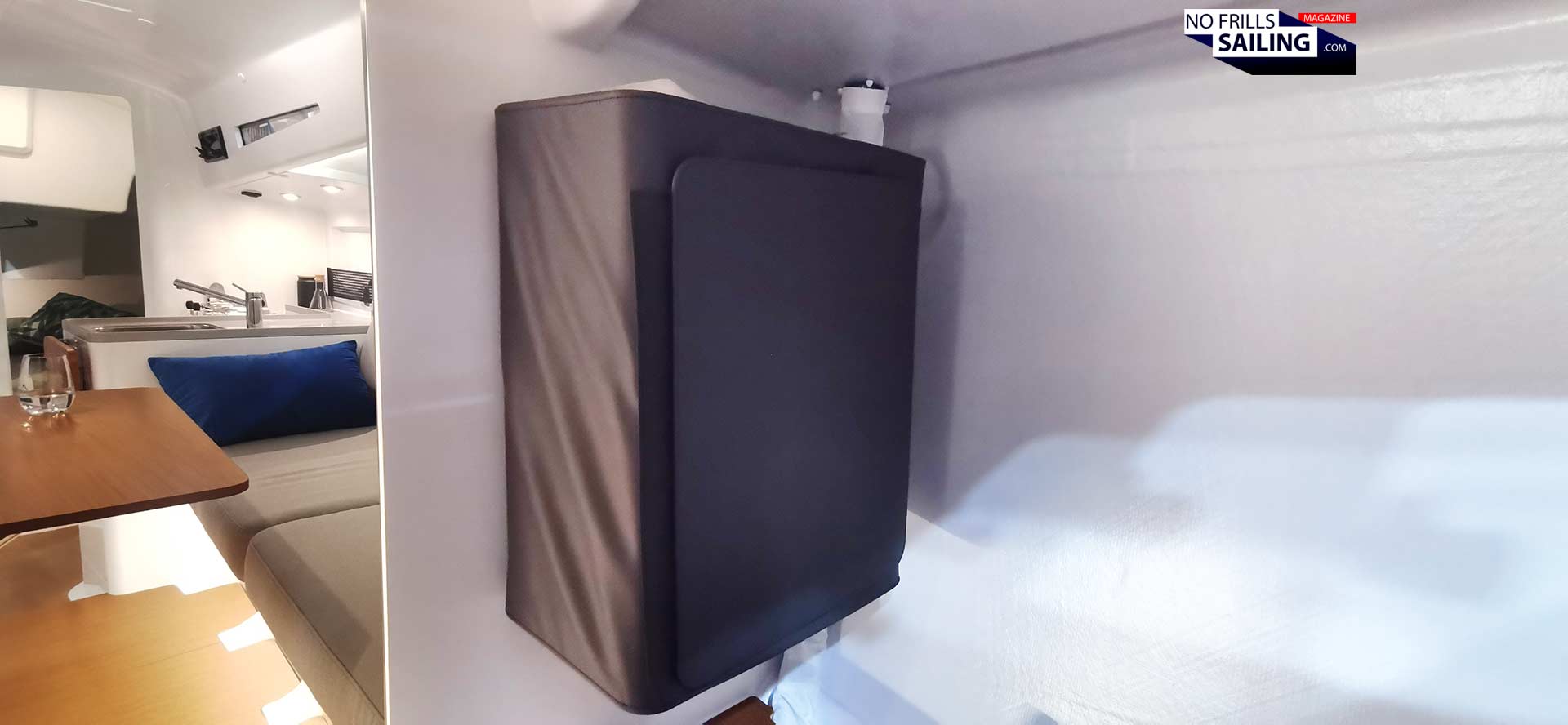
Having these „mobile“ cabinets makes you unbelievably versatile. Just like they have done in the smaller First-models with their ingenious hanging-bags, these cabinets could be taken home, filled with the clothing you want to take with you on the sailing trip, and then simply hung to their place aboard. When arriving back after the trip, you just take them with you – no need for re-packing and stowing huge duffel bags anymore.
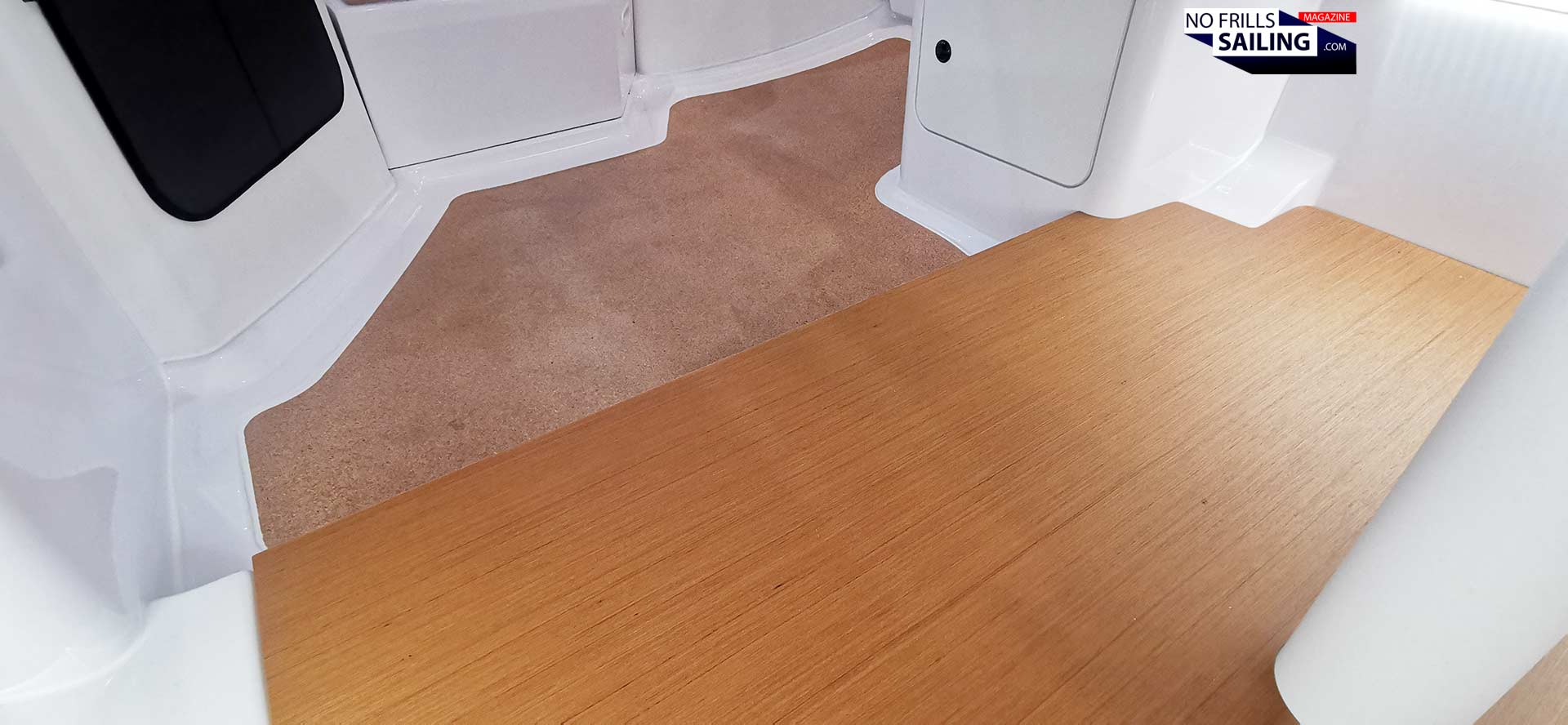
What I strongly dislike (and I know the guys don´t want to hear that) is the choice for the interior floor. I don´t like the mix of wooden floor boards and Cork-decking. I like Cork, that´s not the problem, but I dislike the mix of both. Why having floor boards in the saloon anyway? Depending on what´s beneath: Take them out (which saves surplus weight) and have Cork in all of the boat?! Or offer a more custumer-friendly option with EVA-foam: In this, the clients could choose from a variety of colors to individualize their First 30. Either way, the wooden floor boards would be the first in my own boat to being taken out … Other than that, the First 30 is truly a banger!
Is this the currently hottest 30 footer on the market?
Well. Yes. The development team, the guys at Beneteau and Seascape as well as the external partners can surely be proud of their work! Success in the market is guaranteed: Up until the end of the 9-day-boat show they´ve told me that the 2025 production was sold out, making for the first 50 units. Astonishing! Will she sail well? I am sure! „This would be the first ever boat that Sam Manuard fucked up“ – said Andraz Mihelin. And right he is!
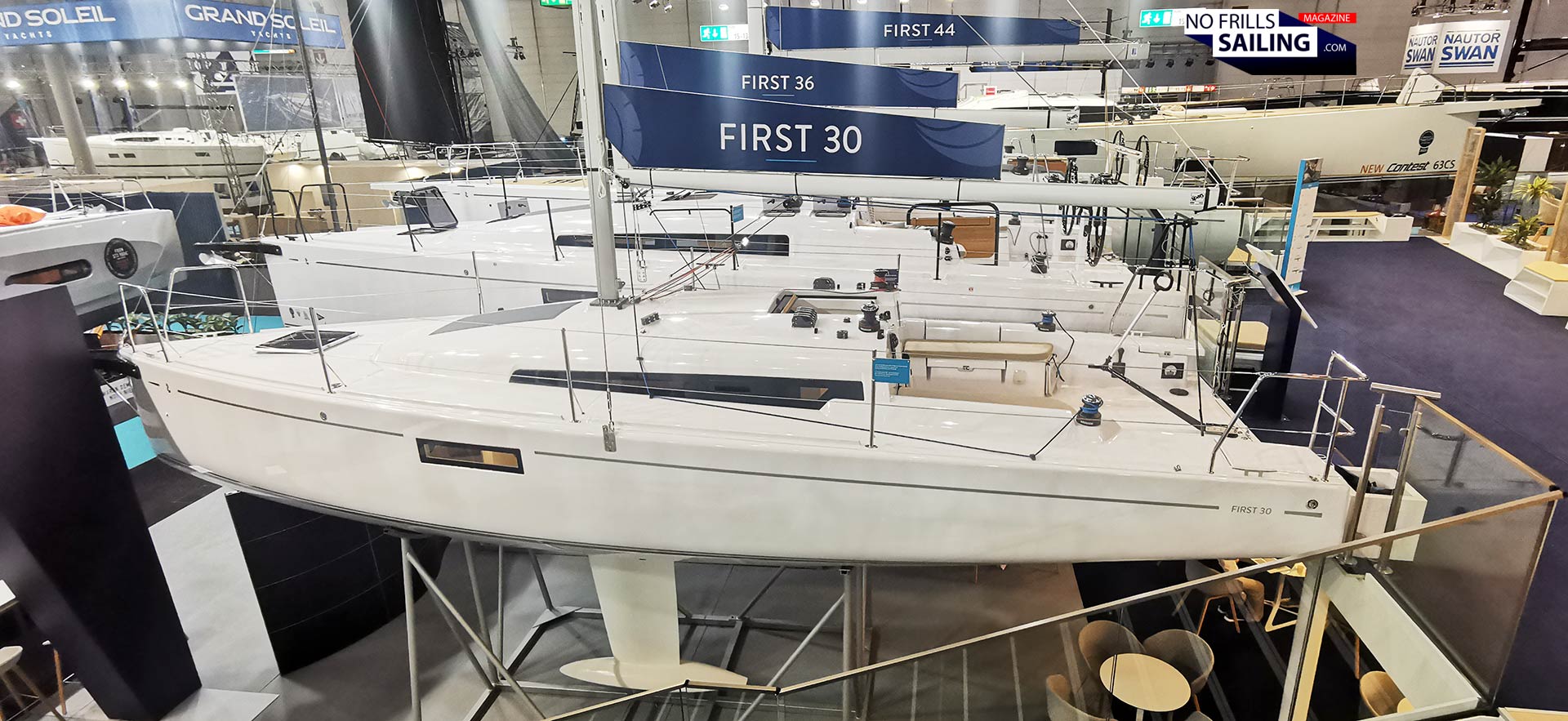
It turned out that the first ever built First 30 – meaning the hull #1 shown in this article – ended up being 100 kilograms lighter than calculated. This is amazing since normally boats become lighter only if over time production is improved. With a light displacement of just 3.050 kilograms, the joy of effortless planing will become reality for skippers on this boat easily. I hope I can confirm this myself soon!
You may also be interested in these related articles:
The „Avengers of Sailing“: Argento, Manuard & Co design the First 36
Sailing the Juan K First 30 – in cruising and racing mode
All Seascape-related articles with hashtag #thinkseascape
